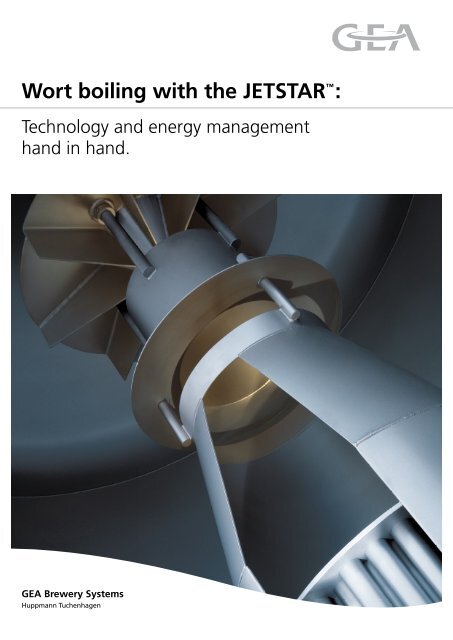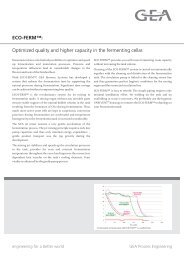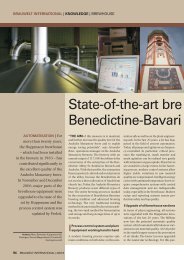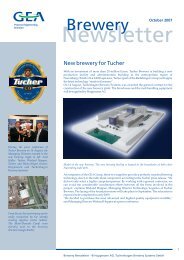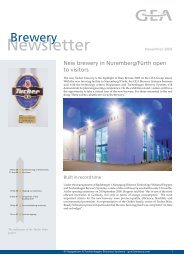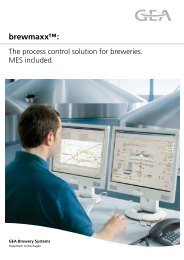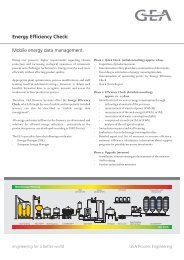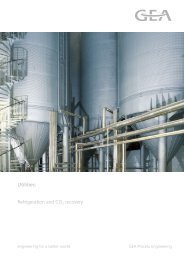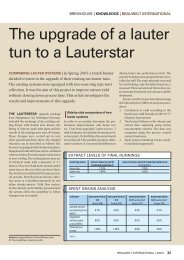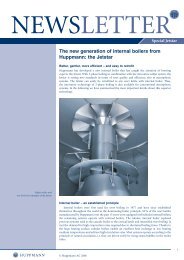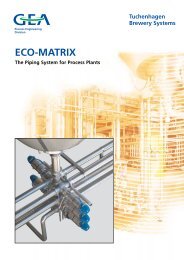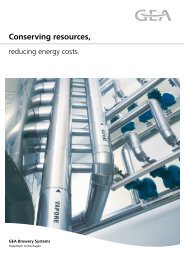Wort boiling with the JETSTAR⢠: - GEA Brewery Systems
Wort boiling with the JETSTAR⢠: - GEA Brewery Systems
Wort boiling with the JETSTAR⢠: - GEA Brewery Systems
You also want an ePaper? Increase the reach of your titles
YUMPU automatically turns print PDFs into web optimized ePapers that Google loves.
<strong>Wort</strong> <strong>boiling</strong> <strong>with</strong> <strong>the</strong> JETSTAR :<br />
Technology and energy management<br />
hand in hand.<br />
<strong>GEA</strong> <strong>Brewery</strong> <strong>Systems</strong><br />
Huppmann Tuchenhagen
In wort <strong>boiling</strong> a comprehensive approach pays off.<br />
In order to achieve optimal results in <strong>the</strong> hot<br />
phase in <strong>the</strong> brewhouse all processes and energy<br />
management need to be considered as one entity.<br />
This is precisely what <strong>GEA</strong> <strong>Brewery</strong> <strong>Systems</strong><br />
does. We see state-of-<strong>the</strong>-art wort <strong>boiling</strong> as an<br />
interrelated package comprised of <strong>the</strong> heating-up<br />
process 1 , <strong>the</strong> actual wort <strong>boiling</strong> 2 and <strong>the</strong><br />
wort treatment during cast-out 3 . Each individual<br />
step has a decisive impact on <strong>the</strong> next one. And<br />
each step contributes to <strong>the</strong> overall optimisation of<br />
<strong>the</strong> process in terms of outstanding beer quality<br />
and efficient production.<br />
Vapour<br />
condenser<br />
Return<br />
energy storage<br />
From wort<br />
pre-run tank<br />
From<br />
energy<br />
storage<br />
<strong>Wort</strong> kettle<br />
Condensate<br />
2<br />
Whirlpool<br />
<strong>Wort</strong> aeration<br />
<strong>Wort</strong><br />
heater<br />
1<br />
<strong>Wort</strong><br />
Energy storage<br />
3<br />
<strong>Wort</strong> cooler<br />
Warm water<br />
To <strong>the</strong><br />
f e r m e n t i n g<br />
room<br />
Cold water<br />
FACTS & FIGURES<br />
External wort pre-heating<br />
When using an energy storage system <strong>the</strong> wort is gently raised<br />
to <strong>boiling</strong> temperature via an external plate heat exchanger.<br />
Compared to heating <strong>with</strong> a conventional internal boiler, this<br />
process protects <strong>the</strong> higher-molecular foam-positive nitrogen and<br />
considerably reduces <strong>the</strong> <strong>the</strong>rmal stress, which benefits <strong>the</strong> taste<br />
stability of <strong>the</strong> beers produced using this technique.<br />
2
Technical solutions to match all requirements.<br />
<strong>GEA</strong> <strong>Brewery</strong> <strong>Systems</strong> offers <strong>the</strong> entire range of<br />
wort <strong>boiling</strong> options to perfectly meet <strong>the</strong> widest<br />
ranging requirements. We have spent decades<br />
perfecting <strong>the</strong> construction of low-pressure <strong>boiling</strong><br />
systems. From energy storage systems to vapour<br />
compression units and combined whirlpool/<br />
wort kettles we can offer suitable solutions that<br />
represent <strong>the</strong> state of <strong>the</strong> art in technology. For<br />
any type of brewhouse and for any type of beer.<br />
Gentle pre-cooling, less DMS<br />
The DMS concentration in <strong>the</strong> finished product can be significantly<br />
reduced using wort pre-cooling during cast-out. This is achieved<br />
using a separate small plate heat exchanger or by cooling down<br />
a partial wort flow <strong>with</strong> <strong>the</strong> customary wort cooler. This process<br />
does not affect <strong>the</strong> warm water balance of <strong>the</strong> brewhouse.<br />
FACTS & FIGURES<br />
Vapour condenser<br />
Energy recovery in <strong>the</strong> brewhouse kicks in at <strong>the</strong> point where<br />
most <strong>the</strong>rmal energy is used in <strong>the</strong> brewery: during wort <strong>boiling</strong>.<br />
Apart from <strong>the</strong> start-up and shut down quantities, which are<br />
technically unavoidable, <strong>the</strong> vapour condenser also significantly<br />
reduces vapour emission.<br />
3
Dynamic <strong>with</strong> highest flexibility.<br />
<strong>GEA</strong> <strong>Brewery</strong> <strong>Systems</strong> was <strong>the</strong> first company<br />
to develop low-pressure <strong>boiling</strong> to maturity. And<br />
we also continuously enhanced this technology,<br />
which subsequently developed into <strong>the</strong> Dynamic<br />
Low-Pressure Boiling (Dyn. LPB). Today we<br />
combine this process <strong>with</strong> <strong>the</strong> JETSTAR , a novel<br />
internal boiler system <strong>with</strong> a unique flow pattern.<br />
With this innovative internal boiler we managed<br />
to completely redesign <strong>the</strong> wort <strong>boiling</strong> process.<br />
Due to <strong>the</strong> Subjet – an adjustable opening below<br />
<strong>the</strong> wort surface – wort <strong>boiling</strong> is becoming more<br />
flexible, and <strong>the</strong> process is controlled even more<br />
accurately. During wort heat-up <strong>the</strong> Subjet is<br />
open and <strong>the</strong> wort flows back into <strong>the</strong> wort kettle<br />
below <strong>the</strong> wort surface. Without counter pressure<br />
<strong>the</strong> circulation rate of <strong>the</strong> internal boiler increases<br />
and wort homogeneity improves, which reduces<br />
<strong>the</strong>rmal stress during heat-up.<br />
Pressure<br />
[mbar]<br />
Time [min]<br />
Filling<br />
Heating<br />
Phase 1<br />
Phase 2<br />
Pressure relief<br />
Cast-out<br />
Pressure build-up<br />
Pressure reduction<br />
FACTS & FIGURES<br />
Dynamising <strong>the</strong> process<br />
The advantage of <strong>the</strong> Dyn. LPB is <strong>the</strong> even faster evaporation of<br />
undesirable odorous substances due to <strong>the</strong> intense intermittent<br />
<strong>boiling</strong>. As soon as <strong>the</strong> predetermined pressure is reached<br />
a systematic pressure reduction starts under strictly defined<br />
conditions.<br />
As pressure is reduced <strong>the</strong> <strong>boiling</strong> temperature in <strong>the</strong> vessel<br />
decreases accompanied by a rapid steam bubble formation<br />
throughout <strong>the</strong> entire kettle. This “controlled <strong>boiling</strong> delay” results<br />
in a very large gas/liquid contact surface thus ensuring an optimum<br />
stripping of volatile odorous substances.<br />
4
Phase 1 – Thermal conversion<br />
At <strong>the</strong> beginning of <strong>the</strong> <strong>boiling</strong> process <strong>the</strong><br />
Subjet stays open. Then, a <strong>boiling</strong> phase <strong>with</strong> an<br />
extremely low evaporation rate follows, however,<br />
offering <strong>the</strong> possibility to individually influence<br />
<strong>the</strong> temperature-dependent reactions, such as hop<br />
isomerization, protein coagulation, reduction of<br />
undesirable odorous substances and formation<br />
of important flavour components, via <strong>the</strong> time<br />
parameter. High circulation rates at low steam<br />
pressure preserve <strong>the</strong> foam-positive substances in<br />
<strong>the</strong> wort.<br />
The perfect mixing of <strong>the</strong> kettle content ensures<br />
a homogeneous wort temperature.<br />
Phase 2 – Evaporation<br />
For <strong>the</strong> evaporation phase <strong>the</strong> lower Subjet<br />
opening is now closed. By adjusting steam<br />
pressure <strong>the</strong> evaporation rate is increased to <strong>the</strong><br />
necessary value, and <strong>the</strong> wort circulates via <strong>the</strong><br />
two-level wort deflector. The large surface area<br />
thus created ensures an intense evaporation<br />
of undesirable odorous substances. Due to <strong>the</strong><br />
extensive reduction of <strong>the</strong> DMS precursor in phase<br />
1 a comparably low evaporation rate is sufficient<br />
to achieve <strong>the</strong> desired final content of free DMS<br />
and o<strong>the</strong>r flavour components in <strong>the</strong> cast-out<br />
wort. This two-phase wort <strong>boiling</strong> process is not<br />
only suitable for atmospheric kettles, but can also<br />
be combined <strong>with</strong> Dynamic Low-Pressure Boiling<br />
(as shown here).<br />
Phase 1<br />
Phase 2<br />
FACTS & FIGURES<br />
rel. DMS-P [-]<br />
1.0<br />
0.9<br />
0.8<br />
0.7<br />
0.6<br />
0.5<br />
0.4<br />
0.3<br />
0.2<br />
Conventional<br />
JETSTAR<br />
<strong>Wort</strong> distribution in <strong>the</strong> kettle<br />
Implementing <strong>the</strong> JETSTAR results in a dramatic improvement of<br />
<strong>the</strong> mixing process in wort kettles <strong>with</strong> internal boiler. Due to an<br />
increased impulse exchange <strong>the</strong> formerly known short circuit flows<br />
are almost completely eliminated, and temperature distribution<br />
is improved. The more homogeneous temperature distribution<br />
accelerates conversion processes. The chart illustrates <strong>the</strong><br />
comparison of DMS-P degradation between a conventional internal<br />
boiler and a JETSTAR .<br />
0.1<br />
0<br />
0 10 20 30 40 50 60 70 80 90 100<br />
Time [min.]<br />
Trial conditions: constant atmospheric <strong>boiling</strong>, same brewhouse,<br />
brew lenth, raw material composition etc.<br />
5
Technically superior: <strong>the</strong> JETSTAR .<br />
<strong>GEA</strong> <strong>Brewery</strong> <strong>Systems</strong> has been relying on <strong>the</strong><br />
internal boiler for wort <strong>boiling</strong> for a long time<br />
now. It offers marked advantages over an external<br />
boiler. The internal boiler works on <strong>the</strong> basis of<br />
a purely physical principle: steam bubbles create<br />
a density difference between <strong>the</strong> wort in <strong>the</strong><br />
internal boiler and <strong>the</strong> surrounding kettle, thus<br />
ensuring continuous circulation. This principle,<br />
also known as natural circulation, operates <strong>with</strong>out<br />
additional circulation pump and minimizes<br />
mechanical stress on <strong>the</strong> wort. With internal<br />
boilers, wort circulation rates are much higher<br />
than <strong>with</strong> external boilers. During <strong>boiling</strong>, wort is<br />
circulated 20–30 times per hour, which ensures<br />
a homogeneous temperature throughout <strong>the</strong><br />
entire wort kettle. The tube bundle is located<br />
right in <strong>the</strong> middle of <strong>the</strong> medium to be heated;<br />
it emits heat straight into <strong>the</strong> wort and not to <strong>the</strong><br />
surroundings. With <strong>the</strong> JETSTAR , our newest<br />
design of internal boilers, we achieve better<br />
homogeneity right from <strong>the</strong> start of wort heating.<br />
Vapour condenser<br />
to energy<br />
storage<br />
<strong>Wort</strong> kettle<br />
<strong>Wort</strong> kettle<br />
Condensate<br />
from energy storage<br />
<strong>Wort</strong><br />
<strong>Wort</strong><br />
FACTS & FIGURES<br />
Pressure control during Dyn. LBP<br />
Depending on whe<strong>the</strong>r a vapour condenser is used or not, various<br />
methods can be employed to control <strong>the</strong> pressure. In plants <strong>with</strong>out<br />
vapour condensation (see left) we install a bypass pressure control<br />
valve in <strong>the</strong> vapour pipe. When using a vapour condenser, <strong>the</strong><br />
pressure is controlled via <strong>the</strong> water feed from <strong>the</strong> energy storage<br />
tank. The water feed is heavily throttled during <strong>the</strong> pressure build-up<br />
phase.<br />
6
Two-level wort<br />
spreader<br />
Efficient evaporation using <strong>the</strong> two-level<br />
wort spreader.<br />
The patent protected two-level wort spreader<br />
distributes <strong>the</strong> wort over <strong>the</strong> wort surface on two<br />
different levels. The more homogeneous flow<br />
conditions and <strong>the</strong> larger surface area ensure a<br />
particularly efficient evaporation of undesirable<br />
odorous substances, at <strong>the</strong> same time significantly<br />
reducing foam formation on <strong>the</strong> wort surface.<br />
Subjet orifice<br />
Cone<br />
Tubular heat<br />
exchanger<br />
Always hygienically safe<br />
The JETSTAR allows optimal cleaning. In contrast to systems<br />
<strong>with</strong> circulation pump it enables complete drainage of water<br />
and detergents <strong>with</strong>out residues. A short intermediate cleaning<br />
during <strong>the</strong> normal brewing process always ensures constant<br />
<strong>boiling</strong> conditions. The short program includes pre-rinsing <strong>with</strong><br />
water, caustic cleaning, neutralizing and post-rinsing <strong>with</strong> water<br />
and takes only 20 minutes. The time involved does not affect <strong>the</strong><br />
brew cycle time.<br />
FACTS & FIGURES<br />
Steam/Hot water<br />
Condensate/Hot water<br />
7
JETSTAR :<br />
Technology and energy<br />
management<br />
At <strong>GEA</strong> <strong>Brewery</strong> <strong>Systems</strong> we understand state-of-<strong>the</strong>-art wort <strong>boiling</strong> as<br />
an interrelated package comprised of <strong>the</strong> heating-up process, <strong>the</strong> actual<br />
wort <strong>boiling</strong> and <strong>the</strong> wort treatment during cast-out. Only <strong>the</strong> holistic<br />
approach achieves best values in terms of beer quality and in energy<br />
efficiency. This brochure explains <strong>the</strong> individual aspects.<br />
The JETSTAR development contributes considerably to efficiency<br />
and quality improvements in wort <strong>boiling</strong>. Here we show you how we<br />
implement <strong>the</strong> system.<br />
Process Engineering<br />
<strong>GEA</strong> <strong>Brewery</strong> <strong>Systems</strong> GmbH<br />
Huppmann Tuchenhagen<br />
Locations:<br />
Heinrich-Huppmann-Str. 1, 97318 Kitzingen, Germany<br />
Phone +49 9321 303-0, Fax +49 9321 303-603<br />
Am Industriepark 2–10, 21514 Büchen, Germany<br />
Phone +49 4155 49-0, Fax +49 4155 49-2770<br />
info@gea-brewery.com, www.gea-brewery.com<br />
JETSTAR .E.06.09 / © <strong>GEA</strong> <strong>Brewery</strong> <strong>Systems</strong> GmbH. / All rights reserved. Subject to modifications. Printed in Germany.


